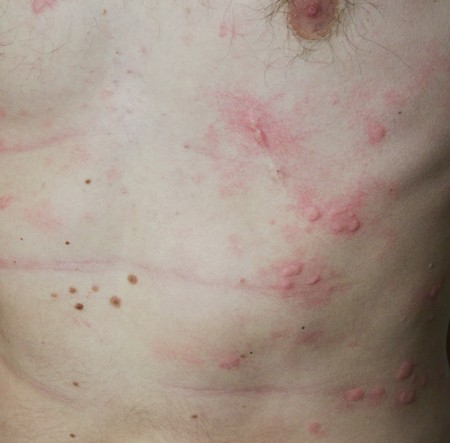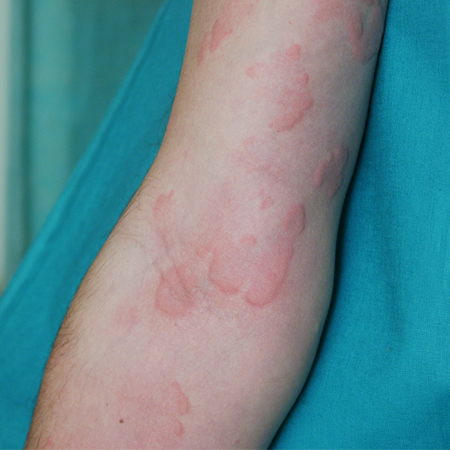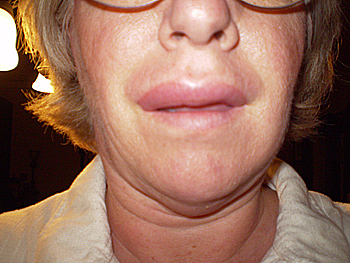Summary
Differentials
Common
- Acute spontaneous urticaria
- Chronic spontaneous urticaria
- Chronic inducible (physical) urticaria
- Drug eruptions
- Insect bite
- Viral exanthem
- Atopic dermatitis
- Allergic contact dermatitis
- Irritant contact dermatitis
Uncommon
- Erythema multiforme
- Stevens-Johnson syndrome
- Auriculotemporal syndrome
- Bullous pemphigoid
- Cutaneous mastocytosis
- Systemic mastocytosis
- Mast cell activation syndrome
- Urticarial vasculitis
- Transfusion reactions
- Serum sickness
- Cold-induced urticaria, Muckle-Wells syndrome, neonatal multisystem inflammatory disease
- Anaphylaxis
Contributors
Authors
Marilyn Li, MD
Associate Professor of Clinical Pediatrics, Clinician Educator
Director, Quality Improvement and Educational Activities For The Breathmobile Program
Keck School of Medicine, USC
Los Angeles
CA
გაფრთხილება:
ML is an unpaid board member of the California Society of Allergy Asthma and Immunology (CSAAI). ML has created CME content on asthma, anaphylaxis, and immunotherapy.
Kenny Y.C. Kwong, MD
Clinical Associate Professor of Pediatrics
Division of Allergy-Immunology
Los Angeles General Medical Center
Los Angeles
CA
გაფრთხილება:
KYCK is a consultant and independent contractor for Thermo-Fisher Scientific Immunodiagnostics Division (Phadia).
მადლიერება
Dr Marilyn Li and Dr Kenny Y.C. Kwong would like to gratefully acknowledge Dr Nanette Silverberg, and Dr Mary Lee-Wong, previous contributors to this topic.
გაფრთხილება:
NS and MLW declare that they have no competing interests.
რეცენზენტები
Christopher Parrish, MD
Assistant Professor
Pediatrics and Internal Medicine
Division of Allergy and Immunology
UT Southwestern
TX
გაფრთხილება:
CP declares that he has no competing interests.
Amor Kachamoune, MD
Assistant Professor
New York University School of Medicine
New York
NY
გაფრთხილება:
AK declares that he has no competing interests.
Bettina Wedi, MD
Professor
Head of Allergy Division
Department of Dermatology and Allergy
Hannover Medical School
Hannover
Germany
გაფრთხილება:
BW declares that she has no competing interests.
რეცენზენტების განცხადებები
BMJ Best Practice-ის თემების განახლება სხვადასხვა პერიოდულობით ხდება მტკიცებულებებისა და რეკომენდაციების განვითარების შესაბამისად. ქვემოთ ჩამოთვლილმა რეცენზენტებმა თემის არსებობის მანძილზე კონტენტს ერთხელ მაინც გადახედეს.
გაფრთხილება
რეცენზენტების აფილიაციები და გაფრთხილებები მოცემულია გადახედვის მომენტისთვის.
წყაროები
ძირითადი სტატიები
Bernstein JA, Lang DM, Khan DA, et al. The diagnosis and management of acute and chronic urticaria: 2014 update. J Allergy Clin Immunol. 2014 May;133(5):1270-7. აბსტრაქტი
European Dermatology Forum. The international EAACI/GA²LEN/EuroGuiDerm/APAAACI guideline for the definition, classification, diagnosis, and management of urticaria. Sep 2021 [internet publication].სრული ტექსტი
Sabroe RA, Lawlor F, Grattan CEH, et al. British Association of Dermatologists guidelines for the management of people with chronic urticaria 2021. Br J Dermatol. 2022 Mar;186(3):398-413.სრული ტექსტი აბსტრაქტი
Moellman JJ, Bernstein JA, Lindsell C, et al. A consensus parameter for the evaluation and management of angioedema in the emergency department. Acad Emerg Med. 2014 Apr;21(4):469-84.სრული ტექსტი აბსტრაქტი
გამოყენებული სტატიები
ამ თემაში მოხსენიებული წყაროების სრული სია ხელმისაწვდომია მომხმარებლებისთვის, რომლებსაც აქვთ წვდომა BMJ Best Practice-ის ყველა ნაწილზე.

პაციენტის ბროშურები
Dermatitis (seborrheic) of the body
მეტი პაციენტის ბროშურებიშედით სისტემაში ან გამოიწერეთ BMJ Best Practice
ამ მასალის გამოყენება ექვემდებარება ჩვენს განცხადებას


